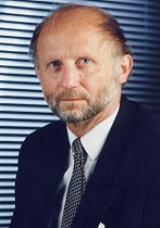
Achim Müller
Encyclopedia
Achim Müller
is a German
scientist
(see categories). He is working now with his research group at the Faculty of Chemistry, University of Bielefeld.
2000, Prix Gay-Lussac/Humboldt 2001, Sir Geoffrey Wilkinson Prize 2001, Centenary Lecture of the Royal Society of Chemistry 2008/9, London) as well as named lectureships.
 His currently most compelling research relates to bottom-up pathways towards tailor-made porous nanoclusters and their use as versatile materials (systems that are now addressed in research worldwide), including:
His currently most compelling research relates to bottom-up pathways towards tailor-made porous nanoclusters and their use as versatile materials (systems that are now addressed in research worldwide), including:
Müller's discovery of the molecular giant sphere
s (keplerates) of the type Mo132 (diameter ca. 3 nm), of the wheel shaped cluster Mo154 and lemon shaped cluster
Mo368 (as large as 6 nm) has caused a paradigm shift not only regarding sizes of molecules but also their worldwide use as nanomaterials
. These single molecules are
quite large; this can be shown by taking the length of an oxygen
molecule
with two atom
s (length 0.12 nm) as a meter, then to place Mo368
which is 50 times as large. Müller's recent work demonstrates how cellular processes like ion-transport can be modeled in relation to spherical oxomolybdate capsules. All these clusters
belong to a class commonly known as polyoxometalate
s and some special ones to the molybdenum blue
family.
is a German
Germany
Germany , officially the Federal Republic of Germany , is a federal parliamentary republic in Europe. The country consists of 16 states while the capital and largest city is Berlin. Germany covers an area of 357,021 km2 and has a largely temperate seasonal climate...
scientist
Scientist
A scientist in a broad sense is one engaging in a systematic activity to acquire knowledge. In a more restricted sense, a scientist is an individual who uses the scientific method. The person may be an expert in one or more areas of science. This article focuses on the more restricted use of the word...
(see categories). He is working now with his research group at the Faculty of Chemistry, University of Bielefeld.
Academic career
Achim Müller studied chemistry and physics at the University of Göttingen and received there his PhD degree (1965) and the Habilitation (1967). In 1971 he became professor at the University of Dortmund, and since 1977 he is professor of Inorganic Chemistry at the University of Bielefeld. His research involves the chemistry of transition metals in synthesis, spectroscopy, and theory with relation to nanochemistry in general, bioinorganic chemistry including biological nitrogen fixation, magnetochemistry, molecular physics and popularised science and natural philosophy. He has published, besides numerous original papers, more than 40 reviews and is coeditor of 14 books. Achim Müller is a member of some leading academies (e.g. Deutsche Akademie der Naturforscher Leopoldina) and is recipient of numerous awards (honorary doctor degrees, -professorships and -memberships) and prizes (e.g. Alfred Stock Memorial PrizeAlfred Stock Memorial Prize
The Alfred-Stock Memorial Prize or Alfred-Stock-Gedächtnispreis is an award for "an outstanding independent scientific experimental investigation in the field of inorganic chemistry." It is awarded annually by the German Chemical Society...
2000, Prix Gay-Lussac/Humboldt 2001, Sir Geoffrey Wilkinson Prize 2001, Centenary Lecture of the Royal Society of Chemistry 2008/9, London) as well as named lectureships.
Research

- multi-supramolecular chemistry on sphere surfaces
- striking examples for a supramolecular/chemical Darwinism
- modelling cation and counter cation transport through membranes
- new solution states for inorganic ions through vesicle formation
- coordination chemistry at the surface, in the pores and in the cavity of the nanocapsules
- encapsulation chemistry in general
- versatile linking in different phases: films, monolayers, liquid crystals
- unprecedented molecular magnets.
Müller's discovery of the molecular giant sphere
Sphere
A sphere is a perfectly round geometrical object in three-dimensional space, such as the shape of a round ball. Like a circle in two dimensions, a perfect sphere is completely symmetrical around its center, with all points on the surface lying the same distance r from the center point...
s (keplerates) of the type Mo132 (diameter ca. 3 nm), of the wheel shaped cluster Mo154 and lemon shaped cluster
Mo368 (as large as 6 nm) has caused a paradigm shift not only regarding sizes of molecules but also their worldwide use as nanomaterials
Nanomaterials
Nanomaterials is a field that takes a materials science-based approach to nanotechnology. It studies materials with morphological features on the nanoscale, and especially those that have special properties stemming from their nanoscale dimensions...
. These single molecules are
quite large; this can be shown by taking the length of an oxygen
Oxygen
Oxygen is the element with atomic number 8 and represented by the symbol O. Its name derives from the Greek roots ὀξύς and -γενής , because at the time of naming, it was mistakenly thought that all acids required oxygen in their composition...
molecule
with two atom
Atom
The atom is a basic unit of matter that consists of a dense central nucleus surrounded by a cloud of negatively charged electrons. The atomic nucleus contains a mix of positively charged protons and electrically neutral neutrons...
s (length 0.12 nm) as a meter, then to place Mo368
which is 50 times as large. Müller's recent work demonstrates how cellular processes like ion-transport can be modeled in relation to spherical oxomolybdate capsules. All these clusters
belong to a class commonly known as polyoxometalate
Polyoxometalate
In chemistry, a polyoxometalate is a polyatomic ion, usually an anion, that consists of three or more transition metal oxyanions linked together by shared oxygen atoms to form a large, closed 3-dimensional framework....
s and some special ones to the molybdenum blue
Molybdenum blue
Molybdenum blue is a term applied to:*reduced heteropolymolybdate complexes, polyoxometalates containing Mo, Mo, and a hetero atom such as phosphorus or silicon...
family.

